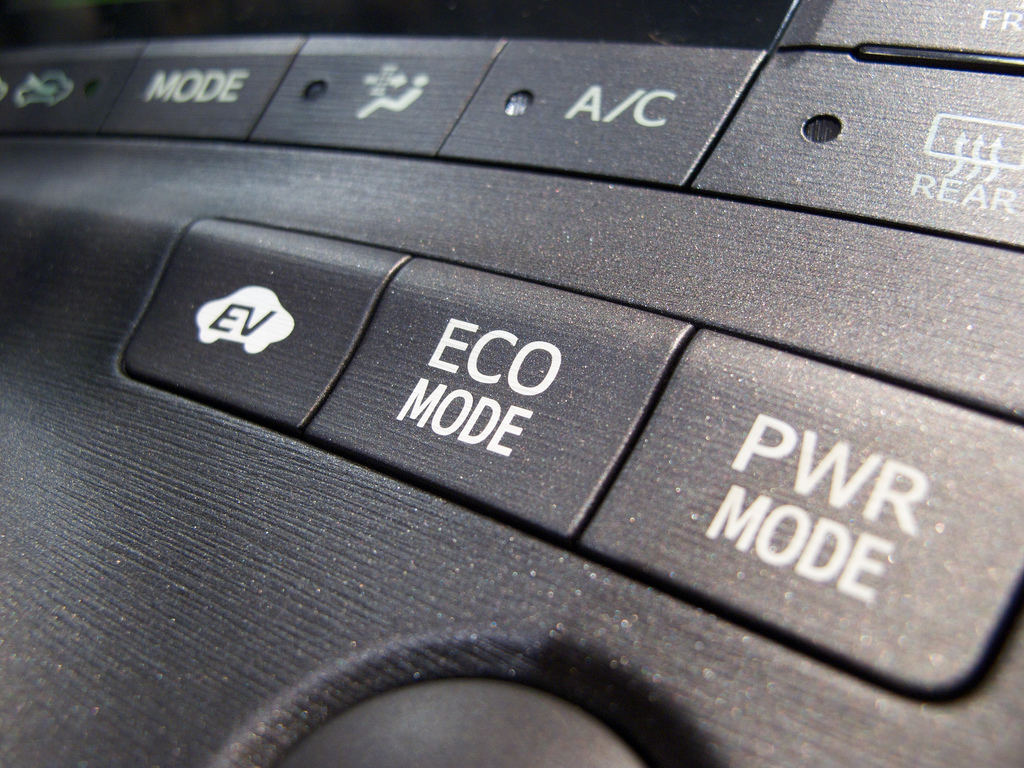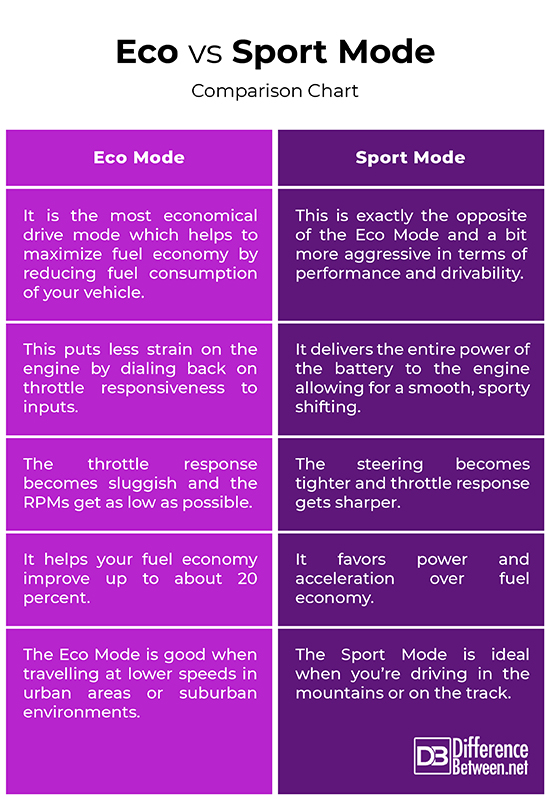Difference Between Eco and Sport Mode
Like our favorite superheroes, our vehicles sometimes have superpowers too that we know of as basic drive modes. In the recent years, vehicles have evolved from the basic commute vehicles to the modern all-purpose, heavy-duty vehicles. Today, many modern cars offer the ability to switch from standard to different driving modes, which alter your car’s driving characteristics to aid in regular on-road driving. These modes change the vehicle’s certain aspects such as engine, steering, gearbox or suspension in order to make regular driving more enjoyable and convenient in certain situations. The common drive modes in today’s vehicles are Eco Mode, Comfort Mode and Sport Mode. We’ll only discuss the eco mode and the sports mode in this article and try to breakdown the difference between the two modes.

What is an Eco Mode?
The Economy Mode, commonly known as the Eco Mode, is exactly what it sounds. It is the most economical drive mode in a vehicle that helps to maximize fuel economy by reducing fuel consumption of your vehicle. The moment you push the Eco Mode button, your vehicle immediately puts a leash on power, as it limits acceleration. This puts less strain on the engine by dialing back on throttle responsiveness to inputs making it accelerate slower than usual. It alters some features of the car mechanically so that maximum distance can be covered with less fuel. It regulates the instruments such as air conditioning that use power in your car, which in turn puts less strain on the engine because it does not work as hard to drive those instruments which consume more power. So, you switch the eco mode on to achieve maximum fuel efficiency for those long drives.

What is a Sport Mode?
Sport Mode, as opposed to the Eco Mode, is a bit aggressive mode which changes the attitude and drivability of your vehicle to a different level. The Sport Mode is one of the most popular of the drive modes which is designed to enhance acceleration, making your vehicle’s throttle more sensitive for hair-trigger response. This mode is preferred to provide maximum torque without speed limitations. This is exactly the opposite of the Eco Mode wherein the system supplies the motor with all of the available energy and pushes the engine for a more aggressive drivability with sharpened throttle response, raised shift points and tightened steering. This makes the vehicle hold onto the gears longer thereby achieving utmost torque performance and spirited acceleration. The Sport Mode is used in normal conditions and delivers the entire power of the battery to the engine, offering smooth, sporty shifting.
Difference between Eco and Sport Mode
Mode
– The Eco Mode, short for Economy Mode, is the most economical drive mode in a vehicle which helps to maximize fuel economy by reducing fuel consumption of your vehicle. The Eco Mode helps your fuel economy improve up to about 20 percent. You can select this drive mode to adjust engine power and transmission operation to help maximize fuel economy. The Sport Mode, on the other hand, is the exact opposite of the Eco Mode and a bit more aggressive in terms of performance and drivability. The Sport Mode is more fun because it delivers the entire power of the battery to the engine allowing for a smooth, sport shifting.
Performance
– Turning the Eco Mode on will allow the computer to select and prioritize engine control to improve fuel efficiency. The throttle response becomes sluggish and the RPMs get as low as possible, and the air conditioning system runs as economically as possible. The Eco Mode puts a leash on the power limiting the acceleration and dialing back on throttle responsiveness. The Sport Mode makes the vehicle hold onto the gears longer on automatic transmission cars. The steering becomes tighter on some cars which increase the feedback, and throttle response gets sharper, thereby achieving utmost torque performance and spirited acceleration.
Ideal Use
– The Eco Mode puts a leash on the driver’s aggressive acceleration or alters the acceleration for better fuel economy. This mode is designed to maximize fuel efficiency, so it can be used when travelling at lower speeds in urban areas or suburban environments. If you’re driving up a hill or on highways where you need a better acceleration for fast moving, you probably shouldn’t use the Eco Mode. The Sport Mode adjusts engine transmission and suspension settings, sharpens up your car’s throttle response. It allows for a more sportier and aggressive driving experience, which is an ideal situation when you’re driving in the mountains or on the track.
Eco vs. Sport Mode: Comparison Chart

Summary of Eco vs. Sport Mode
You can adjust your vehicle responsiveness in a variety of ways, from the less responsive but fuel-efficient Eco Mode to the more aggressive Sport Mode which gives you a keenly sharp response for speedy driving. The Eco Mode gives you the most optimal fuel mileage for your vehicle, but the tradeoff is it takes a little bit off the throttle and a little bit of the air conditioning system. It is subtle and great for the environment. The Sport Mode, on the contrary, gives your vehicle more responsive acceleration and you can feel a little bit tighter steering wheel, more responsive handling. This makes you feel like you are in control of your car, but the problem is worse fuel economy.
- Difference Between Caucus and Primary - June 18, 2024
- Difference Between PPO and POS - May 30, 2024
- Difference Between RFID and NFC - May 28, 2024
Search DifferenceBetween.net :
Leave a Response
References :
[0]Emerging Technologies for Electric and Hybrid Vehicles. Basel, Switzerland: MDPI, 2018. Print
[1]Burnete, Nicolae and Bogdan O. Varga. Proceedings of the 4th International Congress of Automotive and Transport Engineering (AMMA 2018). Berlin, Germany: Springer, 2018. Print
[2]Erjavec, Jack. Hybrid, Electric, and Fuel-Cell Vehicles. Massachusetts, United States: Cengage, 2012. Print
[3]Image credit: https://commons.wikimedia.org/wiki/File:Daihatsu_CAST_SPORT%22SA_II%22_(DBA-LA250S-GBSZ)_interior.jpg
[4]Image credit: https://commons.wikimedia.org/wiki/File:Toyota_Prius_mode_selector.jpg
